Introduction – Blue Whale Size Comparison
The Blue Whale, known as the largest animal to have ever existed on Earth, is a true marvel of size and scale. Blue Whale Size Comparison provides a fascinating glimpse into the remarkable dimensions of these magnificent creatures. In terms of length, an average Blue Whale can reach around 82 to 105 feet (25 to 32 meters), while the maximum recorded length is approximately 98 feet (30 meters). These measurements dwarf even the largest whale species.
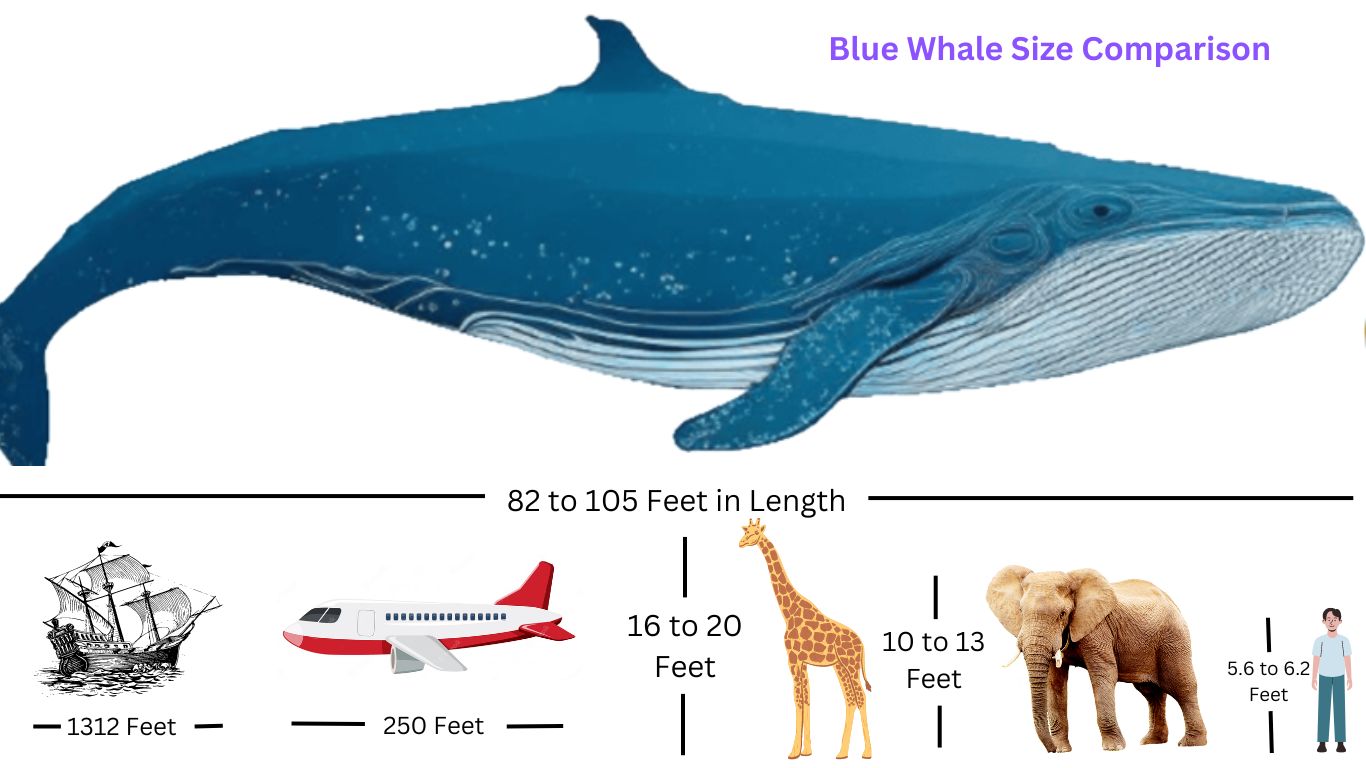
When it comes to weight, Blue Whales average around 100 to 150 metric tons, with the heaviest recorded individual weighing in at a staggering 199 metric tons. This makes them not only larger than any land animal but also heavier than most other marine creatures. The Blue Whale’s colossal size is truly awe-inspiring and serves as a testament to the wonders of the natural world.
Blue Whale Size Statistics
When it comes to size, the Blue Whale reigns supreme as the largest animal ever to have graced our planet. With its colossal dimensions, this magnificent creature never fails to captivate our imagination.
So here below we will delve into the size statistics of Blue Whales, focusing specifically on their length measurements and comparing them to other whale species.
1. Average Length of a Blue Whale:
The average length of a Blue Whale ranges from an impressive 82 to 105 feet (25 to 32 meters). To put this into perspective, it’s as if you were standing in front of a massive creature that spans the length of a basketball court or even a four-story building. This remarkable length is a testament to the grandeur of these gentle giants that roam the oceans.
2. Maximum Recorded Length:
While the average length of a Blue Whale is awe-inspiring in itself, there have been exceptional individuals that have surpassed even these great measurements. The maximum recorded length of a Blue Whale is estimated to be around 98 feet (30 meters). Just envision the sheer magnitude of this massive marine mammal, stretching out almost 100 feet from head to tail. It’s an astonishing sight to behold, emphasizing the incredible nature of these creatures.
3. Comparison with Other Whale Species:
When comparing Blue Whales to other whale species, their length truly sets them apart. Take, for example, the fin whale, often regarded as the second-longest whale species. While it reaches impressive lengths of approximately 79 to 89 feet (24 to 27 meters), it falls short in comparison to the majestic Blue Whale. The Blue Whale’s average and maximum lengths far exceed those of any other known whale species, solidifying its position as the true giant of the seas.
The size statistics of Blue Whales leave us in awe of the sheer scale of these magnificent creatures. Their average length of 82 to 105 feet (25 to 32 meters) and maximum recorded length of approximately 98 feet (30 meters) place them in a league of their own. These gentle giants of the ocean surpass all other whale species in terms of length, underscoring their dominance and magnificence.
As we ponder the size of Blue Whales, it’s important to appreciate the immense diversity and wonders found within our planet’s oceans. The Blue Whale’s colossal dimensions serve as a reminder of the remarkable biodiversity and natural wonders that continue to inspire and amaze us.
Weight measurements
In our exploration of Blue Whale size, we have marveled at their astonishing lengths. Now, let us delve into the weight measurements of these magnificent marine mammals and discover just how massive they truly are. We will uncover the average weight of a Blue Whale, its maximum recorded weight, and even compare their weight to that of other marine animals.
1. Average Weight of a Blue Whale:
The average weight of a Blue Whale ranges between 100 to 150 metric tons. To put this into perspective, imagine the weight of approximately 25 to 37 fully grown African elephants or around 200 to 300 small cars. It’s an astounding figure that showcases the tremendous bulk these creatures carry through the vast oceans.
2. Maximum Recorded Weight:
Blue Whales can reach even more staggering weights. The heaviest recorded Blue Whale weighed in at a mind-boggling 199 metric tons. To visualize this astonishing weight, it’s equivalent to approximately 50 African elephants or over 400 small cars. This enormous mass highlights the incredible capacity of Blue Whales to grow into the largest animals ever known to have existed.
3. Comparison with Other Marine Animals:
When comparing the weight of Blue Whales with other marine animals, they unsurprisingly outshine all contenders. While some larger whale species, such as the fin whale and sperm whale, can reach impressive weights of up to 70 to 80 metric tons, they still pale in comparison to the sheer magnitude of the Blue Whale. In fact, Blue Whales easily surpass the weight of any other marine creature, including mighty creatures like the colossal squid or the ocean sunfish.
The weight measurements of Blue Whales reveal their status as true giants of the deep. With an average weight of 100 to 150 metric tons and a maximum recorded weight of 199 metric tons, they exceed the mass of any other known marine animal. The sheer magnitude of their weight emphasizes their dominance in the marine ecosystem.
As we contemplate the weight of Blue Whales, we are reminded of the immense power and presence they possess. Their impressive weights contribute to their ability to undertake long migrations and feed on vast quantities of krill. The weight statistics of Blue Whales not only highlight their physical grandeur but also underline their critical role in maintaining the delicate balance of the oceanic ecosystem.
In conclusion, the weight measurements of Blue Whales solidify their position as the largest creatures to have ever existed on Earth. With average weights of 100 to 150 metric tons and a maximum recorded weight of 199 metric tons, they are unrivaled in the marine realm. These weighty statistics serve as a testament to the awe-inspiring nature of Blue Whales and the extraordinary wonders that exist beneath the ocean’s surface.
Blue Whale Size Comparison with Man
The blue whale, the largest animal to have ever existed on Earth, is truly a behemoth of the sea. When comparing its immense size to that of a man, the difference is staggering. A fully grown adult male blue whale can reach an astounding length of about 82 to 105 feet (25 to 32 meters), equivalent to the length of multiple buses lined up end to end.
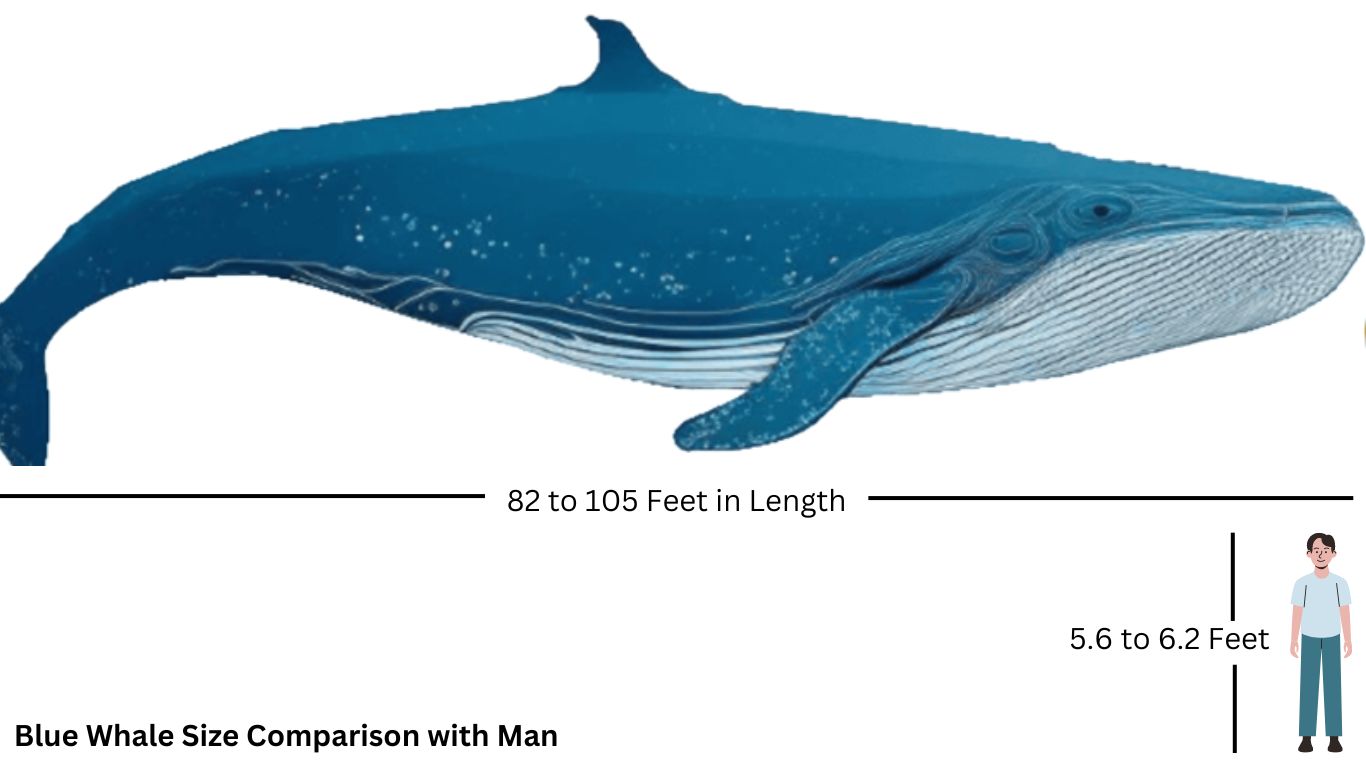
In contrast, an average adult man stands at a mere fraction of the blue whale’s length, measuring around 5.6 to 6.2 feet (1.7 to 1.9 meters). This comparison vividly highlights the awe-inspiring scale of these magnificent marine creatures. The blue whale’s colossal length serves as a reminder of the incredible diversity and grandeur found in our natural world.
Blue Whale Size Comparison with Land Animals: Blue Whales vs. the Titans of the Land
While the Blue Whale’s immense size is often associated with the ocean, it’s fascinating to explore how these leviathans measure up against the giants of the land. Here below, we will compare the height of Blue Whales with the tallest land animals, namely giraffes and elephants. Additionally, we will delve into the unique aspect of neck length to gain a deeper understanding of the extraordinary proportions of these magnificent creatures.
1.Blue Whale Size Comparison with Giraffe:
When it comes to height, giraffes are renowned for their towering stature. On average, a giraffe can reach a height of around 16 to 20 feet (4.8 to 6 meters). In contrast, a Blue Whale’s immense size surpasses even the loftiest giraffe, as their average height reaches a staggering 82 to 105 feet (25 to 32 meters). The Blue Whale’s vertical reach far exceeds that of any land animal, emphasizing their exceptional size and scale.
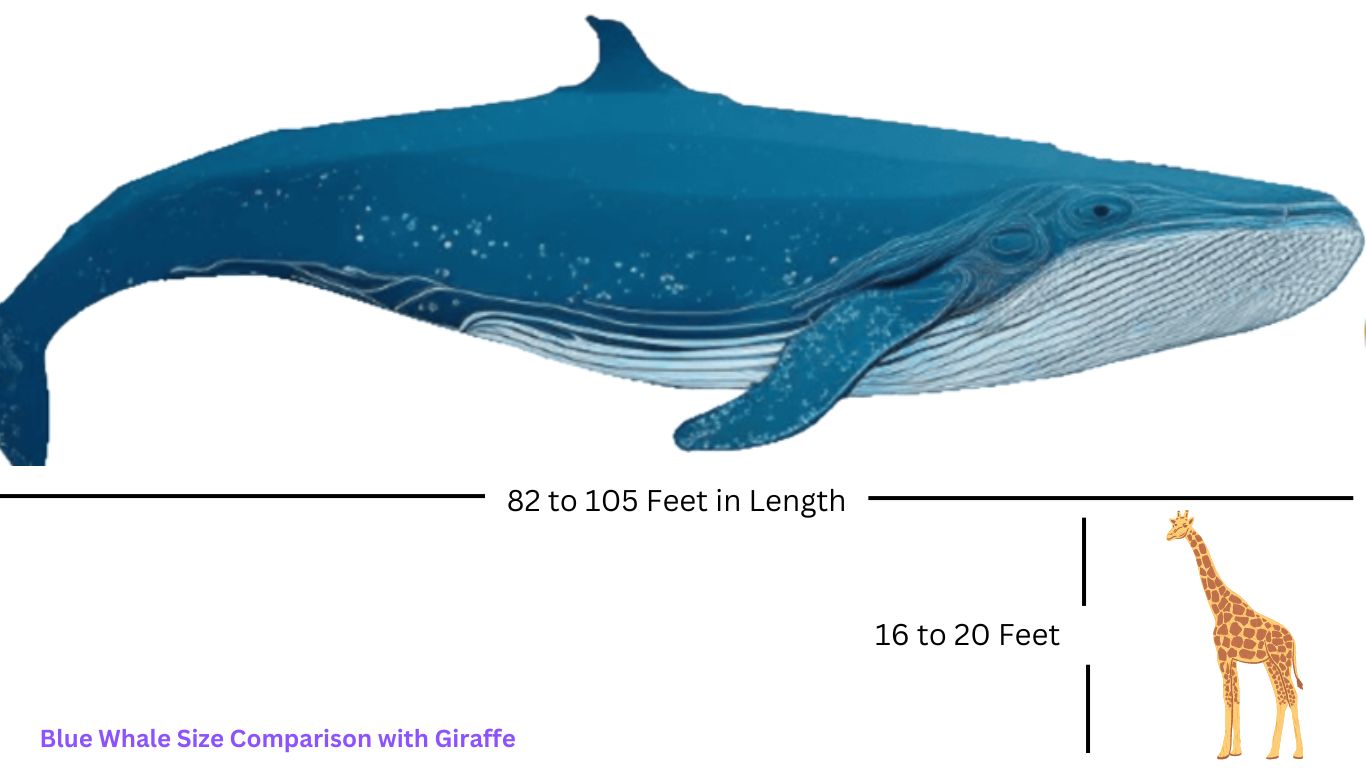
2.Blue Whale Size Comparison with Elephant:
Another notable comparison is with elephants, renowned for their size and strength. An African elephant, considered the largest land mammal, stands at an average height of approximately 10 to 13 feet (3 to 4 meters) at the shoulder. In contrast, the Blue Whale towers over elephants, with an average height that reaches up to seven times taller. This dramatic difference showcases the sheer enormity of Blue Whales, solidifying their status as the largest animals on Earth.
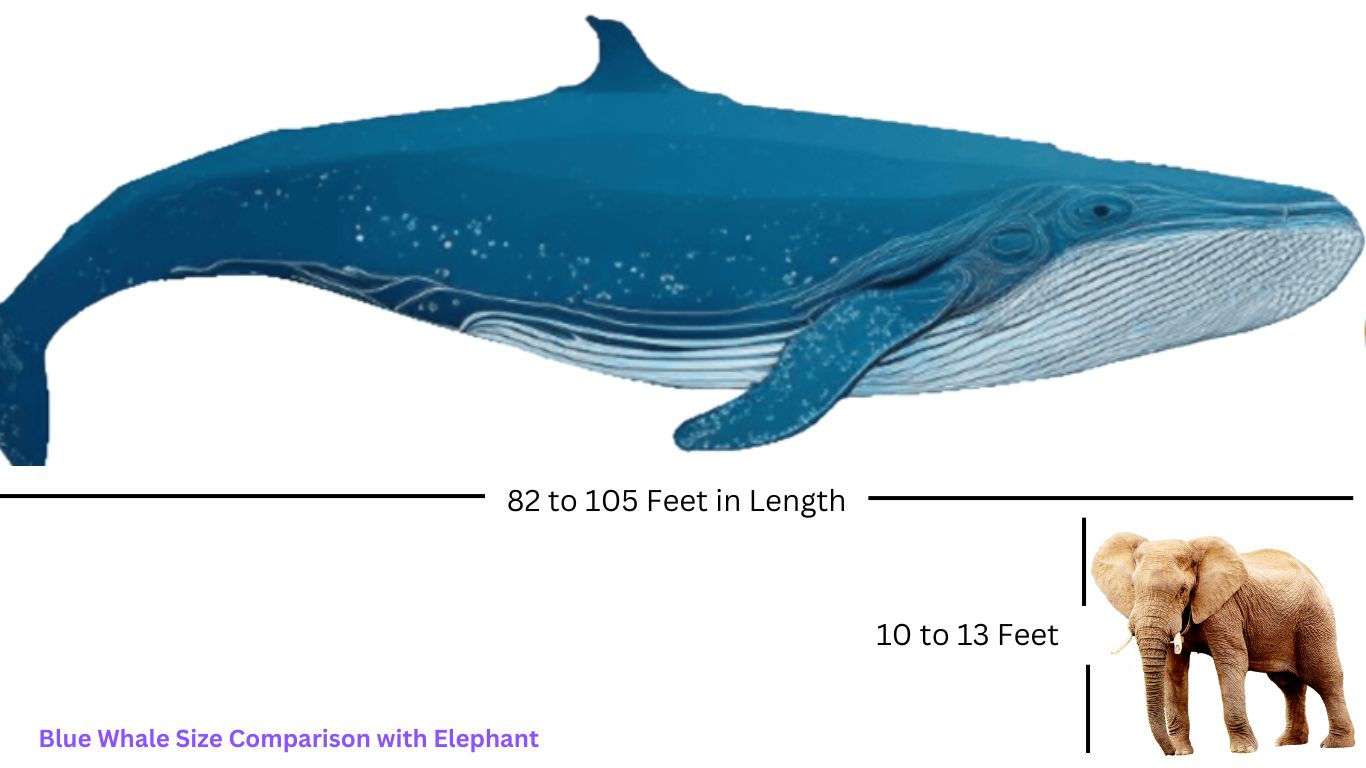
3.Blue Whale Size Comparison of Neck Length:
One distinguishing feature of giraffes is their extraordinarily long necks. A giraffe’s neck can measure around 6 to 8 feet (1.8 to 2.4 meters) in length. However, when comparing the neck length of giraffes to Blue Whales, the contrast is striking. Blue Whales possess relatively shorter necks, with their neck length comprising only a small fraction of their total body length. This adaptation allows them to efficiently filter-feed on the abundant krill in the ocean.
The size comparisons of Blue Whales with land animals, including giraffes and elephants, highlight the unparalleled grandeur of these marine giants. With their average height exceeding the tallest giraffes and dwarfing elephants, Blue Whales reign supreme in terms of vertical stature. Furthermore, their shorter necks emphasize the specialized adaptations that enable them to thrive in their oceanic environment.
As we delve into the size comparisons with land animals, it becomes evident that the Blue Whale’s dimensions are truly extraordinary. Their towering heights surpass those of giraffes and elephants, showcasing the remarkable scale of these magnificent creatures. The Blue Whale’s massive size serves as a constant reminder of the astonishing diversity and wonders found both on land and in the vast expanses of the ocean.
Blue Whale Size Comparison with Land Animals: Blue Whales vs. the Heavyweights of the Land
As we continue our exploration of Blue Whale size, let’s shift our focus to their weight and how they compare to some of the largest land mammals. We will delve into weight comparisons with African elephants, hippopotamuses, and even touch upon the astounding size of dinosaurs.
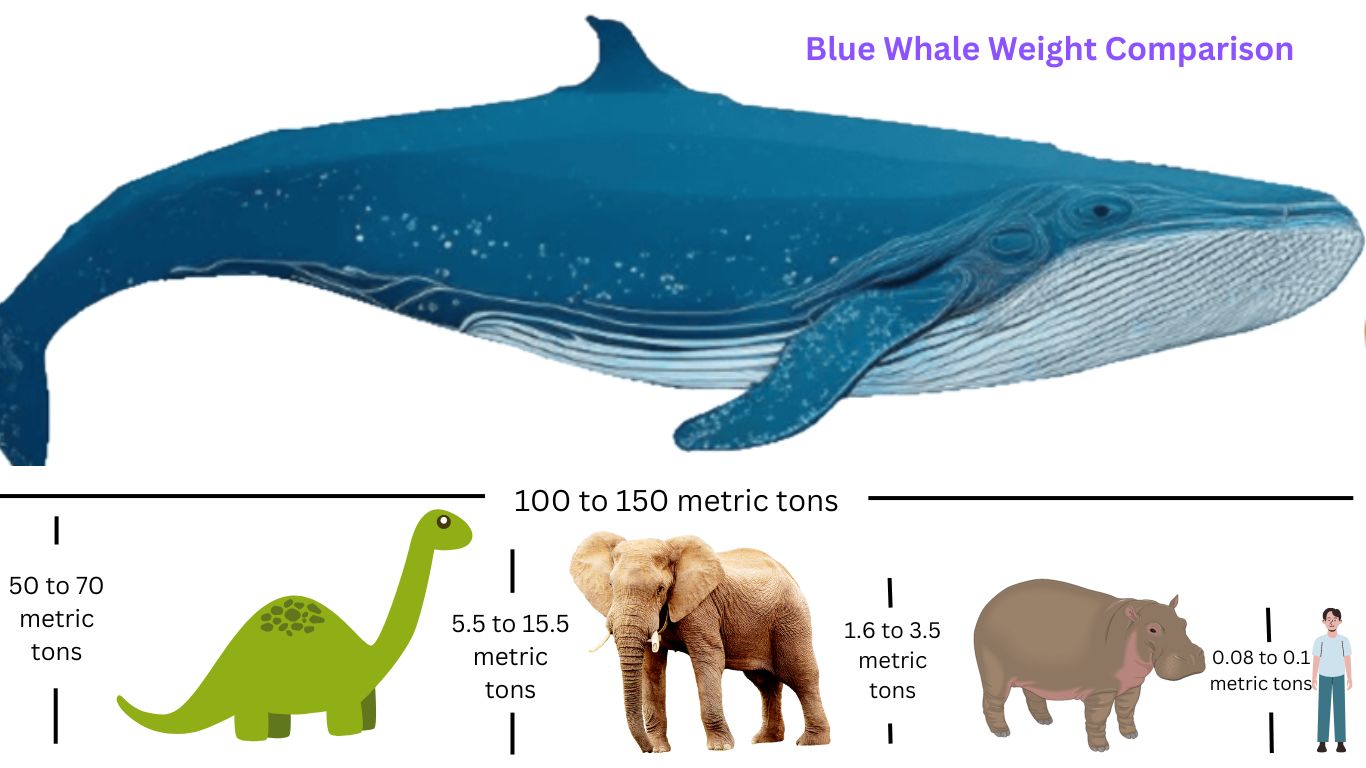
1. African Elephant:
African elephants are known for their impressive size and strength. On average, a male African elephant can weigh between 5,000 to 14,000 kilograms (11,000 to 31,000 pounds). In comparison, Blue Whales far surpass the weight of these land giants. With average weights ranging between 100 to 150 metric tons (110,000 to 165,000 U.S. tons), Blue Whales outweigh African elephants by an astonishing margin. The sheer magnitude of their weight solidifies their status as the true titans of the animal kingdom.
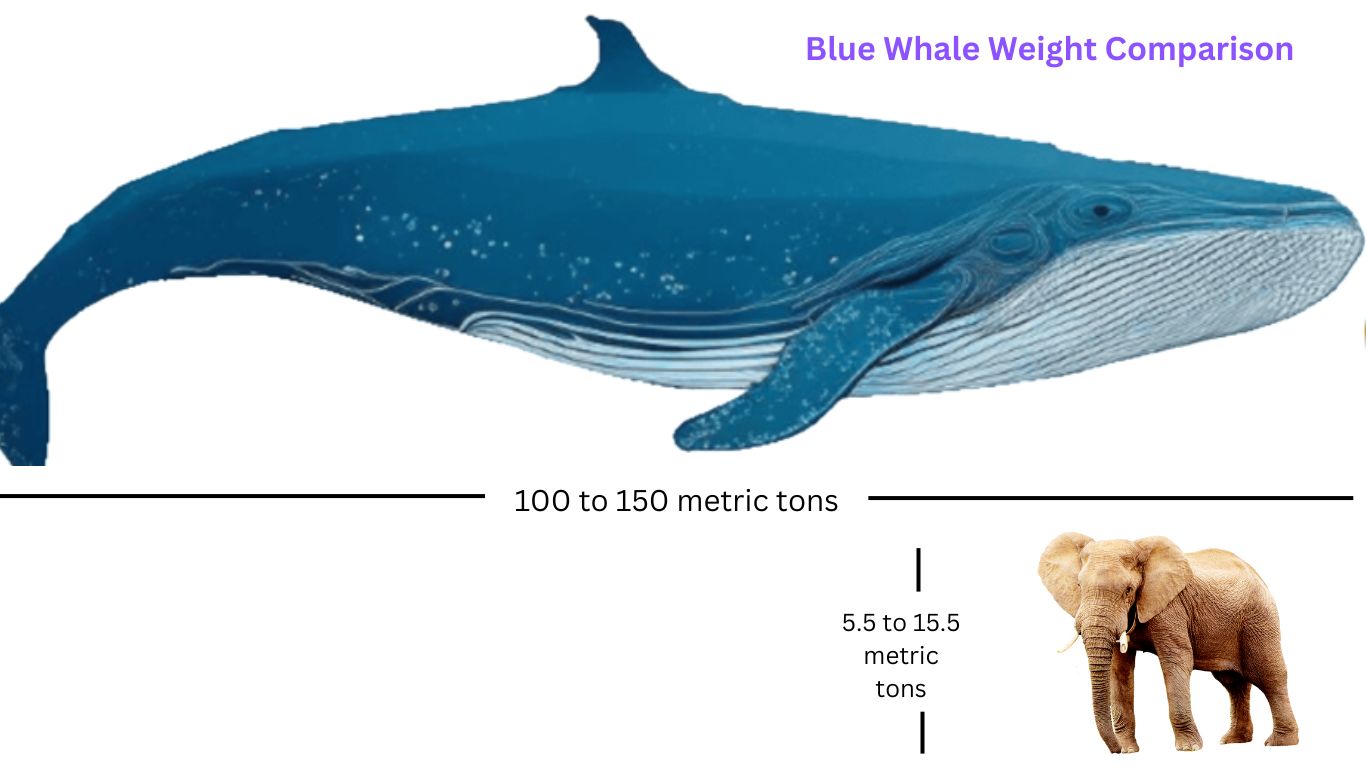
2. Hippopotamus:
Hippopotamuses are known for their robust build and immense size. A fully grown male hippopotamus can weigh around 1,500 to 3,200 kilograms (3,300 to 7,000 pounds). Once again, Blue Whales far exceed the weight of these hefty herbivores. With their average weight of 100 to 150 metric tons (110,000 to 165,000 U.S. tons), Blue Whales outweigh hippopotamuses by several orders of magnitude, showcasing their unparalleled mass.

3. Comparison with Dinosaurs:
To truly comprehend the enormity of Blue Whales, it is intriguing to compare them to the colossal dinosaurs that once roamed the Earth. While it is challenging to determine the precise weight of dinosaurs, some of the largest species, such as Argentinosaurus or Patagotitan, are estimated to have weighed around 50 to 70 metric tons (55,000 to 77,000 U.S. tons). In this comparison, Blue Whales still reign supreme, with average weights of 100 to 150 metric tons (110,000 to 165,000 U.S. tons). This reveals the astonishing scale of Blue Whales as modern-day giants that rival the massive dinosaurs of the past.
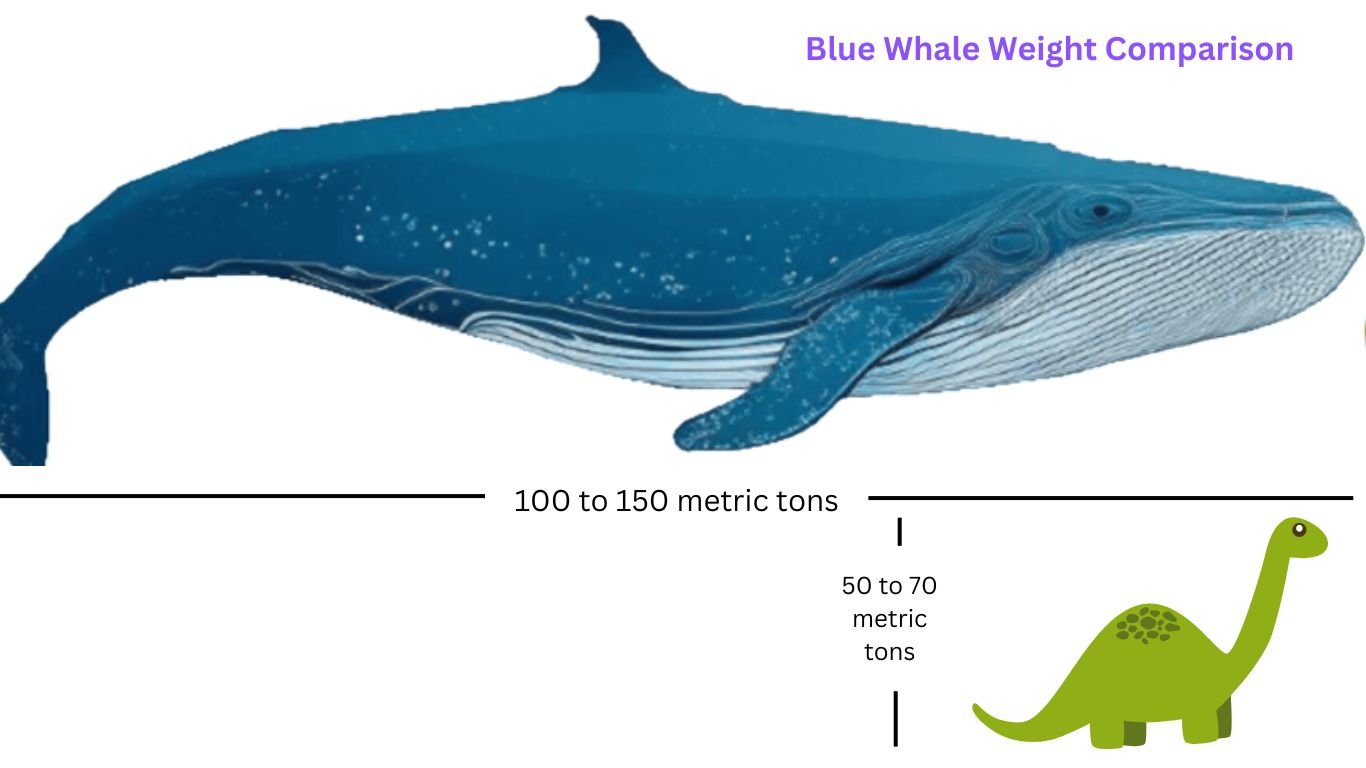
The weight comparisons of Blue Whales with large land mammals and dinosaurs demonstrate their unparalleled mass and dominance. Outweighing African elephants and hippopotamuses by significant margins, Blue Whales truly stand out as the heaviest animals on the planet. Even when compared to colossal dinosaurs, Blue Whales hold their ground as the modern-day champions of weight.
As we reflect on these comparisons, it becomes increasingly apparent that the Blue Whale’s size is truly exceptional. Their colossal weight is a testament to their evolutionary success and the intricacies of their unique marine lifestyle. The weight statistics of Blue Whales not only inspire awe but also remind us of the remarkable diversity and wonders found throughout the animal kingdom, both past and present.
Blue Whale Size Comparison: Unveiling the Immensity Compared to Human-made Objects
The Blue Whale’s awe-inspiring size extends beyond the natural world and even surpasses the dimensions of many human-made objects. In this section, we will explore the length comparisons of Blue Whales with commercial airplanes, ships and submarines, as well as famous structures, revealing the sheer enormity of these magnificent creatures.
1. Commercial Airplanes:
Commercial airplanes are renowned for their impressive lengths. The Boeing 747-8, one of the largest passenger planes, measures approximately 76.3 meters (250 feet) in length. In contrast, the average length of a Blue Whale ranges from 25 to 32 meters (82 to 105 feet). Even the maximum recorded length of a Blue Whale, approximately 30 meters (98 feet), is comparable to the length of some commercial airplanes. This comparison emphasizes the incredible scale of Blue Whales, rivaling the dimensions of these massive aircraft.
2. Ships and Submarines:
Ships and submarines are known for their significant lengths, particularly those designed for cargo or military purposes. For example, the largest container ships can reach lengths of around 400 meters (1,312 feet). While Blue Whales do not match the colossal lengths of these ships, their average and maximum lengths are still substantial in comparison. The scale of a Blue Whale in the water is a testament to their immense size, dwarfing many vessels that navigate the seas.
3. Comparison with Famous Structures:
To further comprehend the size of Blue Whales, we can draw comparisons with famous structures on land. For instance, the Statue of Liberty in New York stands at a height of approximately 93 meters (305 feet). While Blue Whales do not possess the same height, their average lengths of 25 to 32 meters (82 to 105 feet) far exceed the height of this iconic monument. This comparison highlights the length and proportion of Blue Whales in relation to celebrated human-made structures.
The size comparisons of Blue Whales with human-made objects showcase the astonishing dimensions of these marine giants. While they may not exceed the lengths of large commercial airplanes or ships, their lengths rival those of some aircraft and overshadow many famous structures. Blue Whales serve as a reminder of the grandeur and majesty found in the natural world, even in comparison to our most impressive human creations.
As we contemplate the size of Blue Whales in relation to human-made objects, it prompts us to appreciate the incredible diversity of sizes and scales that exist in our world. The Blue Whale’s remarkable size invites us to marvel at the wonders of nature and deepens our understanding of the extraordinary creatures that inhabit our planet’s oceans.
Blue Whale Weight Comparison: Unveiling the Enormity Compared to Human-made Objects
The weight of Blue Whales is truly astonishing, surpassing the bulk of many human-made objects. In this section, we will explore weight comparisons between Blue Whales and large cargo ships, heavy machinery, and even famous monuments, highlighting the extraordinary mass of these magnificent marine creatures.
1. Large Cargo Ships:
Large cargo ships are known for their substantial weight capacities. The Emma Maersk, one of the largest container ships, has a deadweight tonnage of approximately 165,000 tons. In comparison, the average weight of a Blue Whale ranges from 100 to 150 metric tons (110,000 to 165,000 U.S. tons). Blue Whales easily outweigh these massive ships, showcasing their remarkable bulk and making them some of the heaviest creatures on Earth.
2. Heavy Machinery:
Heavy machinery, such as cranes or bulldozers, can be incredibly weighty due to their robust construction. For instance, a large crawler crane can weigh up to 2,000 metric tons (2,200 U.S. tons). When compared to Blue Whales, however, the scale tips dramatically. Blue Whales average around 100 to 150 metric tons (110,000 to 165,000 U.S. tons), surpassing the weight of even the heaviest machinery on land.
3. Comparison with Famous Monuments:
To truly grasp the weight of Blue Whales, we can draw comparisons with famous monuments. The Eiffel Tower in Paris weighs approximately 10,000 metric tons (11,000 U.S. tons). While this iconic structure carries substantial weight, Blue Whales easily outweigh it by a factor of 10 to 15 times. The weight of Blue Whales further emphasizes their remarkable heft and showcases the incredible mass these marine giants possess.
The weight comparisons of Blue Whales with human-made objects demonstrate their unparalleled mass and dominance. Outweighing large cargo ships and heavy machinery, Blue Whales stand as some of the heaviest creatures on Earth. Even when compared to famous monuments, Blue Whales dwarf their weight, showcasing their astonishing bulk.
As we reflect on these comparisons, it becomes increasingly clear that Blue Whales are true giants of the natural world. Their massive weight is a testament to their evolutionary success and the unique adaptations that allow them to thrive in the oceanic environment. The weight statistics of Blue Whales not only inspire awe but also highlight the extraordinary diversity and wonders found throughout our planet, both natural and man-made.
Blue Whale Size Comparison with Natural Context: Unveiling the Magnitude Compared to Geological Features
The size of Blue Whales is awe-inspiring not only in comparison to human-made objects but also when placed in the context of Earth’s natural wonders. In this section, we will explore size comparisons between Blue Whales and geological features, including mountains, waterfalls, and canyons, to provide a deeper appreciation for the grandeur of these magnificent marine creatures.
1. Mountains:
Mountains are renowned for their towering heights and majestic presence. The highest peak on Earth, Mount Everest, reaches an elevation of approximately 8,848 meters (29,029 feet). While Blue Whales do not match the vertical reach of mountains, their immense lengths are comparable. With average lengths ranging from 25 to 32 meters (82 to 105 feet), Blue Whales can span multiple times the length of many mountain peaks. This juxtaposition highlights the impressive scale of Blue Whales in relation to these geological giants.
2. Waterfalls:
Waterfalls are mesmerizing natural phenomena, characterized by cascading water that captivates the senses. Some of the tallest waterfalls, such as Angel Falls in Venezuela, have vertical drops exceeding 979 meters (3,212 feet). While Blue Whales do not possess the same height as waterfalls, their colossal weight makes them substantial in comparison. With average weights ranging between 100 to 150 metric tons (110,000 to 165,000 U.S. tons), Blue Whales demonstrate an extraordinary mass that can rival the power and presence of waterfalls.
3. Canyons:
Canyons are geological formations marked by deep, steep-sided valleys carved by the forces of nature. The Grand Canyon in the United States, for instance, stretches approximately 446 kilometers (277 miles) in length. Although Blue Whales cannot match the length of canyons, their massive size is still remarkable. With average lengths of 25 to 32 meters (82 to 105 feet), Blue Whales can represent a significant portion of the length of certain canyons, illustrating the scale and significance of these marine giants.
The size comparisons of Blue Whales with geological features, including mountains, waterfalls, and canyons, provide a fresh perspective on the immensity of these marine creatures. While Blue Whales may not reach the heights of mountains or waterfalls, their lengths and weights are substantial in relation to these natural wonders. This juxtaposition highlights the remarkable dimensions of Blue Whales and underscores the diversity and marvels found within Earth’s landscapes.
As we contemplate the size of Blue Whales in the context of geological features, it prompts us to marvel at the wonders of nature and reinforces the importance of preserving and protecting these extraordinary environments. The size of Blue Whales serves as a testament to the incredible diversity and magnificence that exists within our planet’s natural realm.
Blue Whale Size Comparison: Unveiling the Scale in Relation to Natural Phenomena
The size of Blue Whales is not only remarkable when compared to human-made objects and geological features but also when placed in the context of awe-inspiring natural phenomena. In this section, we will explore size comparisons between Blue Whales and natural phenomena such as thunderstorms, meteor showers, and volcanic eruptions, shedding light on the immensity of these magnificent marine creatures.
1. Thunderstorms:
Thunderstorms are powerful atmospheric events characterized by thunder, lightning, and intense rainfall. The vertical extent of a thunderstorm can reach up to 10 kilometers (6.2 miles) into the sky. While Blue Whales do not match the vertical reach of thunderstorms, their colossal lengths are impressive in comparison. With average lengths ranging from 25 to 32 meters (82 to 105 feet), Blue Whales can span a significant portion of the horizontal scale of a thunderstorm, emphasizing their size and presence within the natural world.
2. Meteor Showers:
Meteor showers are captivating celestial events that occur when Earth’s atmosphere intersects with a stream of debris left by a comet. During a meteor shower, numerous shooting stars streak across the sky. While Blue Whales are Earth-bound creatures, their massive weight can be compared to the weight and impact of a meteor. With average weights ranging between 100 to 150 metric tons (110,000 to 165,000 U.S. tons), Blue Whales possess a considerable mass that can rival the power and magnitude of a falling meteor, showcasing their significance in the natural order.
3. Volcanic Eruptions:
Volcanic eruptions are awe-inspiring displays of Earth’s geologic activity, unleashing immense energy and reshaping the surrounding landscapes. The volume of material ejected during volcanic eruptions can range from a few cubic meters to several cubic kilometers. While Blue Whales do not match the volume of volcanic eruptions, their sheer weight and size evoke a sense of grandeur. With average lengths of 25 to 32 meters (82 to 105 feet) and weights between 100 to 150 metric tons (110,000 to 165,000 U.S. tons), Blue Whales represent a colossal force in the natural world, akin to the raw power of a volcanic eruption.
The size comparisons of Blue Whales with natural phenomena such as thunderstorms, meteor showers, and volcanic eruptions provide a captivating glimpse into their scale and presence within the natural order. While Blue Whales may not reach the heights of thunderstorms or meteor showers or match the volume of volcanic eruptions, their lengths and weights demonstrate a remarkable magnitude that echoes the power and grandeur.
Conclusion – Blue Whale Size Comparison
Throughout this article, we have explored the size of Blue Whales in various contexts, including comparisons with human-made objects, geological features, natural phenomena, and even other animals. In terms of length, Blue Whales can rival the dimensions of commercial airplanes, ships, and famous structures. When it comes to weight, they surpass the mass of large cargo ships, heavy machinery, and famous monuments. Furthermore, we have seen how Blue Whales compare to mountains, waterfalls, canyons, thunderstorms, meteor showers, and volcanic eruptions, highlighting their significant presence in the natural world.
Understanding the scale of Blue Whale’s size is crucial for appreciating the extraordinary diversity of life on Earth. Blue Whales are the largest animals to have ever existed, and comprehending their immense dimensions helps us comprehend the vastness of our planet and the incredible adaptations nature has produced. Recognizing the size of these majestic creatures also serves as a reminder of the importance of conservation efforts to protect their habitats and ensure their survival.
In conclusion, the size of Blue Whales is truly awe-inspiring. Whether compared to human-made objects, geological features, natural phenomena, or other animals, Blue Whales stand out as majestic giants of the oceans. Their lengths and weights, along with their significant presence in the natural world, evoke a sense of wonder and appreciation for the incredible diversity of life. By delving into the size of Blue Whales, we gain a deeper understanding of the magnificence and importance of these extraordinary creatures, underscoring the need for their protection and conservation in our rapidly changing world.
Some links to other articles
From Backbones to No Bones: Exploring Vertebrates and Invertebrates in Sea Animals
From Krill to Squid: What Do Penguins Eat ?
Are Manatees Dangerous ?: Here’s What You Need to Know
Reference Sites
